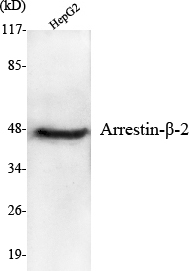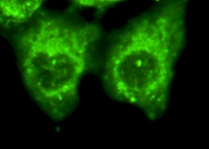Arrestin-β-2 Monoclonal Antibody
- Catalog No.:YM1012
- Applications:WB;IF
- Reactivity:Human;Mouse;Rat;Pig
- Target:
- Arrestin-β-2
- Fields:
- >>MAPK signaling pathway;>>Chemokine signaling pathway;>>Endocytosis;>>Hedgehog signaling pathway;>>Dopaminergic synapse;>>Olfactory transduction;>>Relaxin signaling pathway;>>Parathyroid hormone synthesis, secretion and action;>>GnRH secretion;>>Morphine addiction;>>Chemical carcinogenesis - receptor activation
- Gene Name:
- ARRB2
- Protein Name:
- Beta-arrestin-2
- Human Gene Id:
- 409
- Human Swiss Prot No:
- P32121
- Mouse Gene Id:
- 216869
- Mouse Swiss Prot No:
- Q91YI4
- Rat Gene Id:
- 25388
- Rat Swiss Prot No:
- P29067
- Immunogen:
- Purified recombinant human Arrestin-β-2 (C-terminus) protein fragments expressed in E.coli.
- Specificity:
- Arrestin-β-2 Monoclonal Antibody detects endogenous levels of Arrestin-β-2 protein.
- Formulation:
- Liquid in PBS containing 50% glycerol, 0.5% BSA and 0.02% sodium azide.
- Source:
- Monoclonal, Mouse
- Dilution:
- WB 1:1000 - 1:2000. IF 1:100 - 1:500. Not yet tested in other applications.
- Purification:
- Affinity purification
- Concentration:
- 1 mg/ml
- Storage Stability:
- -15°C to -25°C/1 year(Do not lower than -25°C)
- Other Name:
- ARRB2;ARB2;ARR2;Beta-arrestin-2;Arrestin beta-2
- Molecular Weight(Da):
- 46kD
- Background:
- Members of arrestin/beta-arrestin protein family are thought to participate in agonist-mediated desensitization of G-protein-coupled receptors and cause specific dampening of cellular responses to stimuli such as hormones, neurotransmitters, or sensory signals. Arrestin beta 2, like arrestin beta 1, was shown to inhibit beta-adrenergic receptor function in vitro. It is expressed at high levels in the central nervous system and may play a role in the regulation of synaptic receptors. Besides the brain, a cDNA for arrestin beta 2 was isolated from thyroid gland, and thus it may also be involved in hormone-specific desensitization of TSH receptors. Multiple alternatively spliced transcript variants encoding different isoforms have been found for this gene. [provided by RefSeq, Mar 2012],
- Function:
- function:Regulates beta-adrenergic receptor function. Beta-arrestins seem to bind phosphorylated beta-adrenergic receptors, thereby causing a significant impairment of their capacity to activate G(S) proteins.,online information:Arrestin entry,similarity:Belongs to the arrestin family.,
- Subcellular Location:
- Cytoplasm. Nucleus. Cell membrane. Membrane, clathrin-coated pit . Cytoplasmic vesicle. Translocates to the plasma membrane and colocalizes with antagonist-stimulated GPCRs.
- Expression:
- Brain,Cord blood,Endometrium,Muscle,Pancreas,Testis,Thyroid,
- June 19-2018
- WESTERN IMMUNOBLOTTING PROTOCOL
- June 19-2018
- IMMUNOHISTOCHEMISTRY-PARAFFIN PROTOCOL
- June 19-2018
- IMMUNOFLUORESCENCE PROTOCOL
- September 08-2020
- FLOW-CYTOMEYRT-PROTOCOL
- May 20-2022
- Cell-Based ELISA│解您多样本WB检测之困扰
- July 13-2018
- CELL-BASED-ELISA-PROTOCOL-FOR-ACETYL-PROTEIN
- July 13-2018
- CELL-BASED-ELISA-PROTOCOL-FOR-PHOSPHO-PROTEIN
- July 13-2018
- Antibody-FAQs
- Products Images

- Western Blot analysis using Arrestin-β-2 Monoclonal Antibody against HepG2 cell lysate.

- Immunofluorescence analysis of HeLa cells using Arrestin-β-2 Monoclonal Antibody.



